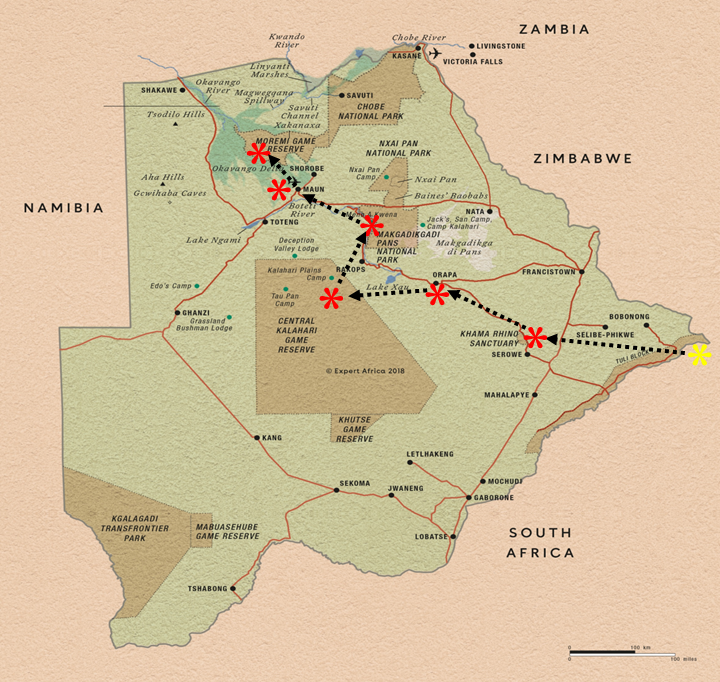
Our party’s first destination is the Okavango Delta, a UNESCO World Heritage Site, and Moremi Game Reserve, and then on to Chobe National Park. This overland journey will take us into some remote country and we will almost certainly be without cell service, and thus internet connection, for 14 days. SO, this will likely be the last you will here from me for at least 14 days. Once again, no we have not been trampled by a cape buffalo (the number one wildlife caused human fatality), chomped in half by an angry hippo (number two I think), or eaten by a hungry lion (perhaps number 3 but I doubt it), so rest easy, as we will certainly be resting easy and enjoying ourselves. However, since I won’t be back on this blog for at least 14 days, unless by some miricle there is wifi at Khwai Village along the way, I thought I would at least give you some background on the Delta before we go. That way, when I am back online I can focus on the campsites and our awesome cool wildlife experiences.
The Okavango Delta is the most outstanding feature of the Kalahari basin and Botswana’s premier wildlife safari attraction. The Okavango Delta is a huge low gradient alluvial fan or ‘Inland Delta’ located in northwestern Botswana. The Delta covers an area of more than 7,700 sq. mi. and includes a vast network of permanent and seasonally-flooded river channels, marshes, swamps, seasonally flooded grassland, riparian woodlands and wooded and grassland islands, big and small. The habitat complexity of the Delta is truly outstanding, and can really only be fully appreciated by seeing it from the air. I had the privilege on a previous trip to take a low-elevation flight over the delta to see this wonderous complexity. Although the following pictures are not my own, I took these off the internet to share with you so that you can get a sense of what I am trying to describe.


The Okavango Delta is one of a very few large inland delta systems in the world without an outlet to the sea, its waters drain instead into the desert sands of the Kalahari Basin. It is Africa’s third largest alluvial fan and the continent’s largest inland delta. Furthermore, it is in a near pristine state, being a largely untransformed wetland system – although it is currently being threatened by oil and water development, and as of yet unknown impacts of climate change. Perhaps the most interesting and important features of the Okavango is its hydrology; in particular, the timing of the flooding of the delta. The Okavango is produced by seasonal flooding. The Okavango River drains the summer (January–February) rainfall from the Angola highlands and the surge in the river begins to flow in around one month. The waters then gradually and slowly spread out over the delta over the next four months (March–June). The flood peaks between June and August, during Botswana’s dry winter months, when the delta swells to three times its permanent size, attracting animals from hundreds of miles around and creating one of Africa’s greatest concentrations of wildlife.
An interesting info-bit on the human side is the use of the Delta for agriculture by the local ethnic people. After the flooding season, the waters in the lower parts of the delta, near the base, recede, leaving moisture behind in the soil. This residual moisture is used for planting fodder and other crops that can thrive on it. This land is locally known as “molapo”.
We are visiting the Delta at the beginning of peak flooding when most of the channels are surging with water and the lagoons are full – creating a watery haven for all kinds of wildlife. More specifically, we are visiting the portion of the Delta protected as part of the Moremi Game Reserve. Moremi GR (1,900 square miles), established in 1963, combines mopane woodland and acacia forests, floodplains and lagoons. Only about 30% of the Reserve is mainland, with the bulk being within the Okavango Delta itself.
Ok, that’s a little background on this truly amazing piece of the world. We’ll see you in a couple of weeks!

The Delta must burst with plant and wildlife and an incredible variety of species munching on species, munching on species. Can’t wait to open to treasure box in 2 weeks time. Travel safely. Cheers, /P
say hello to our fellow camp visitor, the leopard! he loves that flute music !!:-)
enjoy!!!
I will try to lure him in again!
Love the factoids about the delta. Enjoy your trip and hope you see abundant wildlife around the Delta! Big hugs to sister Nanc 💕
Thanks and will certainly do the hugs!
Looks beautiful!
So glad you are there when the water is plentiful. Looks beautiful. Only if man could just leave mother nature alone. Haven’t we ruined enough?
Have a great time. I will miss hearing from you but won’t worry as much now that you have our family with you. Love you all. Hugs and kisses- Sister Joan
ditto!
Love reading your story each day or so…stay safe .two weeks